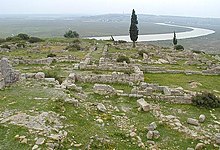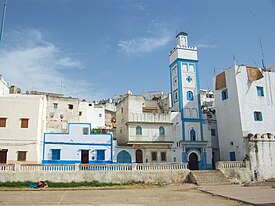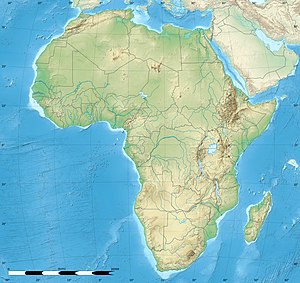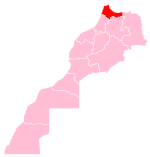Larache
This article needs additional citations for verification. (March 2023) |
Larache
العرائش | |
|---|---|
City | |
| Nickname: The Pearl | |
| Coordinates: 35°11′N 6°9′W / 35.183°N 6.150°W | |
| Country | |
| Region | Tanger-Tetouan-Al Hoceima |
| Province | Larache |
| Founded by the Phoenicians | c. 12th century BC |
| Population (2014)[1] | |
• Total | 125,008 |
| Time zone | UTC+0 (WET) |
| • Summer (DST) | UTC+1 (WEST) |
| Postal code | 92000 |
Larache (Arabic: العرائش, romanized: al-'Ara'ish) is a city in northwestern Morocco. It is on the Moroccan coast, where the Loukkos River meets the Atlantic Ocean. Larache is one of the most important cities of the Tanger-Tetouan-Al Hoceima region.
Many civilisations and cultures have influenced the history of Larache, starting in the ancient city of Lixus during the 12th century BCE. Between the period of being a strategic Berber town and then a Phoenician trading centre to Morocco's independence era around the 1950s, Larache was a nexus for many cultures.
History
[edit]

The city is not mentioned in Arabic historical sources until the 13th century. It was founded by the Idrisite Banu 'Arus.[2] Because of the abundant vines in the area, they named it al-'Ara'ish, meaning "trellis of grape vines", or al-'Arīsh mtā' Bnī 'Arūs ("grape vine trellis of the Banu 'Arus") in longer form.[3] The Almohad caliph Ya'qub al-Mansur (r. 1184–1199) built a fortress here in the late 12th century. In 1270, the Spanish led a successful raid on the city.[3]
In 1471, the Portuguese settlers from Asilah and Tangier drove the inhabitants out of Larache, and again it remained uninhabited until the Saadi Sultan Mohammed ash-Sheikh decided to repopulate it and build a stronghold on the plateau above river Loukos. He constructed a fortress at the entrance to the port as a means of controlling access to the river.
For a long time, attempts by the Portuguese, Spanish and French to take it met with no success. The Portuguese established the nearby Graciosa fortress in 1489. The Kasbah, which was built in 1491 by Moulay en Nasser, later became a pirate stronghold.
In 1610, the town passed to the Spanish, who stayed there until 1689, but who mainly used the ports as trading stops and never really administered the town. Moulay Ismail finally conquered Larache in 1689.
Attacks on Larache continued, but it still remained in Muslim hands. In 1765, a French fleet failed in the Larache expedition. In 1829, the Austrians punitively bombarded the city due to Moroccan piracy.[4] Due to the colonisation era, Spain took Larache in 1911 and held it for 45 years until 1956.
On 7 March 2023, Moroccan archaeologists discovered an ancient tomb dating back over 2,000 years to the Mauretanian period.[5]
Geography
[edit]The city is located on the northwestern coast of Morocco, on the south bank at the mouth of the Loukkos River.[3] It is roughly 80 kilometres (50 mi) southwest of Tangier.[6] The city consists of a compact medina (historic old town), situated next to the river, and a larger "new town", established outside the old medina by the Spanish colonial administration after 1911 and stretching southwards over the coastal plateau.[3][7]
Climate
[edit]Larache has a hot-summer Mediterranean climate (Köppen climate classification Csa) with heavy rainfall. The summers are moderately hot and sunny - ideal for the city's beaches - and the winters are wet and cool. The record high temperature of 46.4 °C (115.5 °F) was registered on July 10, 2021.[8]
| Climate data for Larache (1991–2020) | |||||||||||||
|---|---|---|---|---|---|---|---|---|---|---|---|---|---|
| Month | Jan | Feb | Mar | Apr | May | Jun | Jul | Aug | Sep | Oct | Nov | Dec | Year |
| Record high °C (°F) | 25.2 (77.4) |
29.3 (84.7) |
33.8 (92.8) |
33.5 (92.3) |
42.8 (109.0) |
42.9 (109.2) |
46.4 (115.5) |
45.2 (113.4) |
43.0 (109.4) |
38.1 (100.6) |
34.0 (93.2) |
27.9 (82.2) |
46.4 (115.5) |
| Mean daily maximum °C (°F) | 16.7 (62.1) |
17.5 (63.5) |
19.7 (67.5) |
21.0 (69.8) |
23.9 (75.0) |
26.5 (79.7) |
28.3 (82.9) |
28.7 (83.7) |
27.0 (80.6) |
24.4 (75.9) |
20.2 (68.4) |
17.8 (64.0) |
22.6 (72.7) |
| Daily mean °C (°F) | 12.4 (54.3) |
13.2 (55.8) |
15.2 (59.4) |
16.5 (61.7) |
19.4 (66.9) |
21.7 (71.1) |
23.8 (74.8) |
24.2 (75.6) |
22.6 (72.7) |
20.1 (68.2) |
16.0 (60.8) |
13.7 (56.7) |
18.2 (64.8) |
| Mean daily minimum °C (°F) | 8.2 (46.8) |
8.8 (47.8) |
10.6 (51.1) |
12.2 (54.0) |
14.8 (58.6) |
17.5 (63.5) |
19.2 (66.6) |
19.6 (67.3) |
18.2 (64.8) |
15.7 (60.3) |
11.8 (53.2) |
9.5 (49.1) |
13.8 (56.8) |
| Record low °C (°F) | −3.0 (26.6) |
−0.6 (30.9) |
0.9 (33.6) |
5.6 (42.1) |
7.0 (44.6) |
10.5 (50.9) |
13.0 (55.4) |
13.5 (56.3) |
11.9 (53.4) |
7.2 (45.0) |
2.8 (37.0) |
1.3 (34.3) |
−3.0 (26.6) |
| Average precipitation mm (inches) | 104.7 (4.12) |
69.6 (2.74) |
64.2 (2.53) |
68.3 (2.69) |
30.2 (1.19) |
5.1 (0.20) |
0.8 (0.03) |
2.0 (0.08) |
21.7 (0.85) |
83.5 (3.29) |
129.1 (5.08) |
121.3 (4.78) |
700.5 (27.58) |
| Average precipitation days (≥ 1.0 mm) | 7.8 | 7.4 | 7.2 | 6.9 | 4.1 | 0.8 | 0.2 | 0.4 | 2.3 | 6.5 | 8.1 | 8.9 | 60.6 |
| Source: NOAA[9] | |||||||||||||
Demographics
[edit]In the 2024 Moroccan census, the commune of Larache recorded a population of 133,731 inhabitants.[10]
Economy
[edit]The economy of Larache, Morocco, is influenced by its strategic location along the Atlantic coast. Key aspects include:
Fishing
[edit]Larache's port on the Atlantic Ocean plays a crucial role in the fishing industry. The city supports both artisanal and commercial fishing, with a focus on seafood processing and trade.[11]
Agriculture
[edit]The surrounding fertile lands support agriculture, with crops such as citrus fruits, olives, and vegetables being prominent. This sector is vital for local food production and contributes to the economy.[12]
Trade and Commerce
[edit]The port facilitates trade, acting as a key point for importing and exporting goods. The city’s commercial activities include retail and services, benefiting from its port-based trade.[13][14]
Tourism
[edit]Although not as developed as in some other Moroccan cities, Larache’s historical sites and Atlantic beaches attract visitors, contributing to the local economy through hospitality and cultural activities.[15][16]
Manufacturing
[edit]The city has light manufacturing industries, including food processing and textiles, which help diversify the economy and provide employment.[17]
Overall, Larache's economy is supported by its Atlantic port, agricultural resources, and growing sectors in trade, tourism, and manufacturing.[18]
Sites of interest
[edit]Landmarks
[edit]- Port Lixus
- Plaza de España
- Oued Loukos (Loukkos River)
- Charie Mohammed Al-Khamis (Boulevard Mohammed V)
- Storks Castle
- Boukharis House
- Torres Park
- Jardin of Lions
- The Conservatory of Music
- Kessba, Gebibat & Bab Behar (Old Medina)
- Port of Larache
- Dghoghi Houses
- Balcon Atlantico
- Grave of Jean Genet
Lixus
[edit]
Lixus is the site of an ancient city located in Morocco just north of the modern seaport of Larache on the bank of the Loukkos River. It was built by a Berber king in 1180 BC. Lixus was one of the Kingdom of Mauretania's ancient cities.
It was settled by the Phoenicians in the 7th century BC. Lixus was part of a chain of Phoenician/Carthaginian settlements; other major settlements further to the south are Chellah and Mogador. When Carthage fell to Ancient Rome, Lixus, Chellah and Mogador were annexed to the Kingdom of Mauretania.
This ancient Mauritanian city gradually grew in importance, later coming under Carthaginian domination. After the destruction of Carthage, Lixus fell to Amazigh (Berber) control, reaching its zenith during the reign of the Mauritanian king Juba II.
Some ancient Greek writers located at Lixus the mythological garden of the Hesperides, the keepers of the golden apples. The name of the city which was often mentioned by writers from Hanno the Navigator to the Geographer of Ravenna and confirmed by the legend on its coins and by an inscription. The ancients believed this to be the site of the Garden of the Hesperides and of a sanctuary of Hercules, where Hercules gathered gold apples, more ancient than the one at Cadiz, Spain. However, there are no grounds for the claim that Lixus was founded at the end of the second millennium BC. Life was maintained there nevertheless until the Islamic conquest of North Africa by the presence of a mosque and a house with a patio with walls covered with painted stuccos.
Education
[edit]Larache offers 3 types of education systems: Arabic, French and Spanish . Each offers classes starting from pre-Kindergarten up to the 12th grade, as for German in the three last years of high school. The Baccalauréat, or high school diploma are the diplomas offered after clearing the 12 grades.
Primary education
[edit]There are tens Moroccan primary schools,[19] dispersed across the city. Private and public schools, they offer education in Arabic, French and some school English until the 5th grade. Mathematics, Arts, Science Activities and nonreligious modules are commonly taught in the primary school.
International Schools
[edit]The Colegio Español Luis Vives[20] is a Spanish international school located in Larache, Morocco. It offers a Spanish curriculum to students from preschool through secondary education. The school emphasizes bilingual education, providing instruction in both Spanish and Arabic, with additional language offerings such as French and English. Known for its commitment to fostering a multicultural environment, the Colegio Español Luis Vives aims to promote cultural exchange and mutual understanding between Spanish and Moroccan communities.
Higher education
[edit]Polydisciplinary Faculty of Larache
[edit]The Polydisciplinary Faculty of Larache is part of Abdelmalek Essaâdi University[21] in Morocco. This institution offers a diverse range of programs across various fields of study, including sciences, humanities, and social sciences.[22]
Teacher Training Centre
[edit]The CFI Larache,[23] a Centre for Teacher Training is a higher education institution affiliated with the Ministry of Higher Education, Scientific Research, and Professional Training. The CFI Larache accepts holders of DUT, BTS, DEUG, DEUST, or equivalent diplomas and prepares them with pedagogical and theoretical training for a career as teachers.
ISTA
[edit]The Institut Spécialisé de Technologie Appliquée (ISTA[24]) Larache is a key vocational training institute in Larache, Morocco, affiliated with the Office de la Formation Professionnelle et de la Promotion du Travail (OFPPT). It offers a variety of programs in fields such as mechanics, electronics, computer science, and construction, designed to equip students with both theoretical knowledge and practical skills. The institute aims to prepare graduates for immediate employment by aligning its training with industry needs and providing modern facilities, including laboratories and workshops, to ensure an effective learning environment.
Notable people
[edit]- Nezar, a Moroccan rapper and music artist known for his contributions to the morccan hip-hop scene. He gained recognition with his energetic style and distinctive voice, often blending elements of trap and moroccan rap. His work includes popular tracks and collaborations with other artists in the genre.
- Sidi Jilali bin Abd Allah El-Masbahi, native of Saqiyat al-Hamar, is considered a saint of Larache.
- Lalla Mennana El-Mesbahi (El-Masbahiya), his daughter, is also considered a saint and patroness of the city.
- Tayeb bin Mohamed bin Laarbi El-Mesbahi, The great-grandson of Lalla Mennana, who was in charge of her mausoleum and one of the most revered persons in the city.
- Jean Genet lived for several years and had requested to be buried there. His grave is in the Spanish cemetery of Larache.
- Amina Filali, whose suicide in 2012 sparked a political debate on women's rights and article 475 of the Moroccan penal code.
- Juan Goytisolo, Spanish novelist, is buried in the Spanish cemetery of Larache.
- Mounir Nasraoui, the father of Lamine Yamal, the Spanish national football team's youngest player, was born in Larache.[25]
- Mohamed Chrif Tribak, Moroccan filmaker and screenwriter
Sister cities
[edit]Gallery
[edit]-
Plaza de España
-
Bab Behar or Old Medina
-
Larache Fortress
-
Balcon Atlantico
-
Larache Souk
-
Larache Music Academy
-
Spanish Consulate
-
Iglesia Pilar
-
Oued Loukous
-
Larache and the Atlantic Ocean
See also
[edit]- Larache Province
- Lixus
- Loukkos River
- Chabab Larache an old famous football club from the city
- Oussama Belhcen a musician from Larache
- European enclaves in North Africa before 1830
References and notes
[edit]- ^ "POPULATION LÉGALE DES RÉGIONS, PROVINCES, PRÉFECTURES, MUNICIPALITÉS, ARRONDISSEMENTS ET COMMUNES DU ROYAUME D'APRÈS LES RÉSULTATS DU RGPH 2014" (in Arabic and French). High Commission for Planning, Morocco. 8 April 2015. Retrieved 29 September 2017.
- ^ "Dargahinfo - Complete Collection of Dargahs World Wide". dargahinfo.com. Retrieved 2023-06-03.
- ^ a b c d Yver, G. & Ricard, R. (1960). "al-ʿArāʾis̲h̲". In Gibb, H. A. R.; Kramers, J. H.; Lévi-Provençal, E.; Schacht, J.; Lewis, B. & Pellat, Ch. (eds.). The Encyclopaedia of Islam, Second Edition. Volume I: A–B. Leiden: E. J. Brill. pp. 604–605. OCLC 495469456.
- ^ "'Abd ar-Rasham". Encyclopædia Britannica. Vol. I: A-Ak - Bayes (15th ed.). Chicago, Illinois: Encyclopædia Britannica, Inc. 2010. pp. 17. ISBN 978-1-59339-837-8.
- ^ Kasraoui, Safaa. "Morocco Announces Discovery of 2,000-Old Mauritanian Tomb". moroccoworldnews. Retrieved 2023-03-07.
- ^ The Report: Emerging Morocco 2007. Oxford Business Group. 2007. p. 202. ISBN 978-1-902339-76-4.
- ^ "Larache | Morocco". Encyclopedia Britannica. 15 April 2014. Retrieved 2023-03-08.
- ^ "60105: Larache (Morocco))". ogimet.com. OGIMET. 10 July 2021. Retrieved 13 July 2021.
- ^ "Larache Climate Normals for 1991-2020". National Oceanic and Atmospheric Administration. Archived from the original on 8 October 2023. Retrieved 8 October 2023.
- ^ "Population légale du Royaume du Maroc répartie par régions, provinces et préfectures et communes selon les résultats du Recensement général de la population et de l'habitat 2024". Site institutionnel du Haut-Commissariat au Plan du Royaume du Maroc (in French). Retrieved 2024-11-09.
- ^ "Pêche à Larache. Activités des poissons pour la pêche à Larache". mareespeche.com (in French). Retrieved 2024-08-05.
- ^ https://medias24.com/2022/10/24/agriculture-construction-dun-qualipole-a-larache/.
{{cite web}}: Missing or empty|title=(help) - ^ Faïssal, Najat (2023-01-02). "Des journées pour promouvoir le commerce de proximité à Larache". Aujourd'hui le Maroc (in French). Retrieved 2024-08-05.
- ^ "Construction d'une nouvelle zone d'activités économiques à Larache". Le 360 Français (in French). Retrieved 2024-08-05.
- ^ MAROC, INFOS DE TOURISME. "Larache". Morocco Tourism Info. Retrieved 2024-08-05.
- ^ Dyck, Kevin (2017-01-05). "What to See in the Moroccan Coastal Towns of Larache and Asilah". Mosaic North Africa. Retrieved 2024-08-05.
- ^ Atalayar (2024-07-19). "PROCUMAR announces the official launch of the construction of its new plant in Larache". Atalayar. Retrieved 2024-08-05.
- ^ Samadi, Asmaa; Achelhi, Hicham (2021-11-27). "L'industrie 4.0 dans les zones d'activité économique au Maroc : Cas de la région Tanger-Tétouan-Al-Hoceima". International Journal of Accounting, Finance, Auditing, Management and Economics (in French). 2 (6–1): 327–338. doi:10.5281/zenodo.5730618. ISSN 2658-8455.
- ^ "Enseignement préscolaire: 40 nouvelles unités pour la province de Larache". 11 August 2022.
- ^ Montes Presa, José María (2006). "Colegio Español Luis Vives de Larache". Aljamía. Revista de la Consejería de Educación en Marruecos (Extra 17): 57–58. ISSN 2351-9371.
- ^ https://www.researchgate.net/institution/Abdelmalek_Essaadi_University.
{{cite web}}: Missing or empty|title=(help) - ^ "Présentation de la FPL". FPL (in French). Retrieved 2024-08-05.
- ^ "Répertoire des établissements de formation de formateurs de la Francophonie : Établissements". repertoire.rifeff.org. Retrieved 2024-08-05.
- ^ "ISTA LARACHE - OFPPT". ista-larache.vercel.app. Retrieved 2024-08-05.
- ^ "The story of 16-year-old Lamine Yamal, destined to be Barcelona's next superstar". ESPN.com. 2023-09-10. Retrieved 2024-07-10.

















